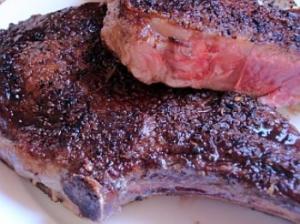Pan-seared Rib Eye Steak

Tags (edit): Roast Quick Fry @Beef @Favorite American thyme vinegare Stock Easy Rib Eye Steak Sear red wine mustard butter Shallots alcohol wine @Really Liked Main Dish
Pan-seared Rib Eye Steak

Tags (edit): Roast Quick Fry @Beef @Favorite American thyme vinegare Stock Easy Rib Eye Steak Sear red wine mustard butter Shallots alcohol wine @Really Liked Main Dish
|
I love steaks grilled outside over hardwood charcoal, but in the middle of winter, in rainy weather or simply when I want a change of taste, pan-searing is the indoor method that's become my hands-down favorite. Pan-searing is the restaurant technique of searing on the stove top, then finishing the dish in the oven. The same advantages of this approach which appeal to busy chefs are also important to home cooks--ease and predictability of results. Pan-searing produces a steak that has a brown, crispy surface with tender, juicy, and flavorful meat inside. Ingredients
1 or 2 Rib eye steak(s) (bone-in or boneless), 1 1/2-inchs thick, at room temperature |
 |
Instructions

Yields: 2 Servings posted as 163593
notes: Searing adds flavor...lots and lots of flavor. The flavor is added to the outside, in the form of caramelization or browning. Searing requires high temperatures to achieve the desired results. As juices escape, the outside of the meat gets drier, and hotter. That hot, dry part of the meat is needed for the chemical reactions to occur that cause intense browning.
The best cut of meat to use with this method of cooking is the rib eye or delmonico steak which have sufficient fat to produce a moist, tender result. Ideally, the steaks should be a minimum of one and a half inches in thickness.
|
Cuisine: American |
Main Ingredient: Beef |
BigOven -- Easy to use recipe organizer for Windows www.bigoven.com